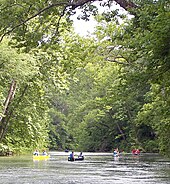Current River (Ozarks)
Source and tributaries
The Current River begins in Montauk State Park located in the southwestern corner of Dent County in southeastern Missouri. The confluence of Pigeon Creek and Montauk Spring form the headwaters of the river. Montauk Spring makes up most of the consistent flow of the headwaters, providing ideal conditions for trout fishing. After leaving Montauk State Park, the river enters the Ozark National Scenic Riverways. The uppermost reaches of the river are swift with numerous riffles broken by deep pools of crystal clear water, further downstream the riffles continue, but get further apart. Hardwood trees, rock ledges, caves, springs, gravel bars, and towering dolomite bluffs line the riverbanks. Welch Spring, a first magnitude spring, enters the river approximately 14 miles (23 km) downstream from the headwaters, nearly doubling the flow of the river. Other notable springs to add to the river include Cave Spring, Pulltite Spring, and Round Spring. Downstream from the headwaters approximately 52 miles (84 km) the Current River receives its largest tributary the Jacks Fork from the west near the small town of Eminence, Missouri. Blue Spring, another first magnitude spring, empties into the river, 9 miles (14 km) downstream from the confluence with the Jacks Fork.
The Current River is approximately 86 miles (138 km) long when it passes by the town of Van Buren and under U.S. Route 60. South of Van Buren a few miles the Current River receives its second biggest tributary, the largest spring in the Ozarks and one of the largest single spring outlets known in the world. Big Spring empties into the river providing nearly 470 cubic feet (13 m) of water per second. From Big Spring the river continues southeasterly leaving the Ozark National Scenic Riverways 105 miles (169 km) from the headwaters. The river then flows through Mark Twain National Forest until reaching Doniphan, Missouri and passes under U.S. Route 160. From here the river slows as it exits the Ozark Highlands, the river continues its slow silt laden path into Arkansas where it receives the Little Black River from the northeast before it joins the Black River near Pocahontas, Arkansas.
Recreational activities

Canoeing, fishing, horseback riding, and camping are popular activities along the Current River. The river is fairly gentle and is considered to have mostly class 1 rapids and a few rated class 2.
Some of the points of interest along the course of the river include Montauk State Park, Welch Spring and its abandoned tuberculosis hospital, Aker's Ferry, Cave Spring, Devil's Well, Deer Leap, Rock House Cave, Pulltite Spring, Round Spring, Jacks Fork, Blue Spring, Rocky Falls (on a small tributary), and Big Spring.
See also
References
- ^ U.S. Geological Survey Geographic Names Information System: Current River (Ozarks)
- ^ U.S. Geological Survey Geographic Names Information System: Montauk Spring
- ^ USGS 07068000 Current River at Doniphan, MO
- ^ Inventory and Assessment for Current River Watershed, Missouri Department of Conservation
- ^ http://www.nps.gov/ozar/ National Park Service
- ^ Vineyard and Feder, Springs of Missouri, Missouri Department of Natural Resources, Division of Geology and Land Survey in cooperation with U.S. Geological Survey and Missouri Department of Conservation, 1982
- ^ USGS Surface Water data for US – Big Spring 1981-2009
Further reading
- Stars Upstream: Life Along an Ozark River, Leonard Hall, University of Chicago Press, Chicago, 1959 ISBN 0-8262-0074-5
- Missouri Ozark Waterways, Oz Hawksley, Missouri Department of Conservation, P.O. Box 180, Jefferson City, MO 65102, 1965, Revised 1989 Conservation Commission of the State of Missouri